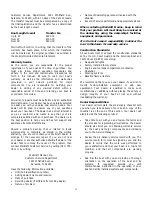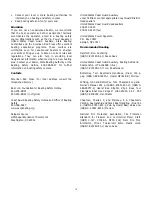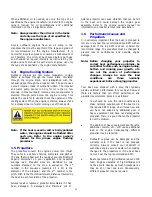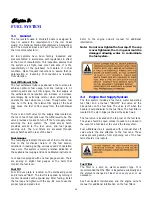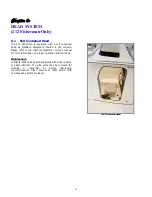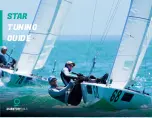
2.7
Control Systems Maintenance
The term “trim” generally refers to the adjustment of the
outboard within the first 20 degree range of travel. This
is the range used while operating your boat on plane.
The term “tilt” is generally used when referring to
adjusting the outboard further up for shallow water
operation or trailering. For information on the proper use
and maintenance of the power tilt and trim please refer
to the engine owner’s manual.
Control Maintenance
Periodic inspection of the control systems and all
connections should be made. Signs of rust, corrosion,
wear, or other deterioration should immediately be
serviced. Generally, periodic lubrication of all moving
parts and connections with a light waterproof grease is
in order. Lubrication should be performed as often as
necessary to keep the system operating smoothly.
Control system adjustments may become necessary. If
adjustments become necessary, see your Wellcraft
dealer.
2.5
Engine Stop Switch
Your boat is equipped with an engine stop switch and
lanyard. When the lanyard is pulled it will engage the
switch and shut off the engines. We strongly
recommend that the lanyard be attached to the driver
whenever the engine is running. If the engine will not
start, it could be because the lanyard is not properly
inserted into the engine stop switch. Always make sure
the lanyard is properly attached to the engine stop
switch before attempting to start the engine.
Steering System Maintenance
A periodic inspection of all steering hoses, linkage and
helm assemblies should be made. Signs of corrosion,
cracking, loosening of fastenings, excessive wear, or
deterioration should be immediately corrected. Failure to
do so could lead to steering system failure that would
result in loss of control.
When new, or after repairs, hydraulic steering systems
may need to have all air purged from the system. Check
the steering fluid level in the helm, it should be
maintained at no less than ½” below the bottom of the
filler cap threads. Only use hydraulic steering fluid
recommended by the steering system manufacturer.
Refer to the engine owner’s manual for more
information on the engine stop switch.
2.6
Steering System
The steering system is hydraulic and made of two main
components: the helm assembly and steering cylinder.
The helm unit acts as both a fluid reservoir and pump.
Turning of the helm. Or steering wheel, pumps the fluid
in the hydraulic hoses and activates the hydraulic
steering cylinder causing the motors to turn. A slight
clicking sound may be heard as the wheel is turned. This
sound is the opening and closing of valves in the helm
unit and is normal.
Remove, clean and grease the support tube and rod
annually with quality marine grease. Refer to the
hydraulic steering manufacturer owner’s manual for
proper specifications and details on system service and
maintenance.
The steering wheel can be tilted to five different
positions by activating the tilt lock lever located on the
bottom side of the helm station. When the lever is
released, it automatically locks the steering wheel at or
close to that angle. Refer to the steering manufacturer
owner’s manual for specific information on the steering
system.
27
Summary of Contents for 180 Sportsman
Page 2: ...2...
Page 4: ...4...
Page 7: ...180 FISHERMAN SPECIFICATIONS 7...
Page 8: ...180 SPORTSMAN SPECIFICATIONS 8...
Page 9: ...202 FISHERMAN SPECIFICATIONS 9...
Page 10: ...212 FISHERMAN SPECIFICATIONS 10...
Page 18: ...18...
Page 39: ...SAFETY LABELS 2601 1124 39...
Page 40: ...180 FISHERMAN 180 SPORTSMAN CAPACITY LABELS 40...
Page 41: ...202 212 FISHERMAN CAPACITY LABELS 41...
Page 61: ...Appendix A SCHEMATICS 180 FISHERMAN INSTRUMENT PANEL 61...
Page 62: ...Appendix A SCHEMATICS 180 SPORTSMAN INSTRUMENT PANEL 62...
Page 63: ...Appendix A SCHEMATICS 202 212 FISHERMAN INSTRUMENT PANEL 63...
Page 68: ...Appendix A SCHEMATICS 180 FISHERMAN 180 SPORTSMAN TRAILER DRAWING 68...
Page 69: ...Appendix A SCHEMATICS 202 212 FISHERMAN TRAILER DRAWING 69...
Page 70: ...Appendix A SCHEMATICS 180 FISHERMAN OVERHEAD LAYOUT 70...
Page 71: ...Appendix A SCHEMATICS 180 SPORTSMAN OVERHEAD LAYOUT 71...
Page 72: ...Appendix A SCHEMATICS 202 FISHERMAN OVERHEAD LAYOUT 72...
Page 73: ...Appendix A SCHEMATICS 212 FISHERMAN OVERHEAD LAYOUT 73...
Page 77: ...MAINTENANCE LOG 77...
Page 78: ...MAINTENANCE LOG 78...
Page 80: ...Appendix D BOAT ACCIDENT REPORT 80...
Page 81: ...81...
Page 87: ...Appendix F TROUBLESHOOTING GUIDE 87...
Page 88: ...TROUBLESHOOTING GUIDE 88...
Page 89: ...TROUBLESHOOTING GUIDE 89...
Page 90: ...TROUBLESHOOTING GUIDE 90...
Page 91: ...TROUBLESHOOTING GUIDE 91...

